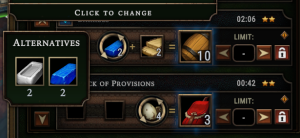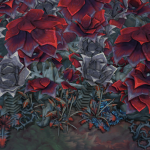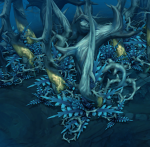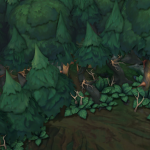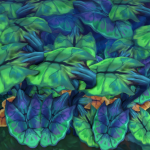Resources
Resources
Gather everything you can and fulfill your villagers needs.
Your Settlement revolves around your resources. Some are gathered from map tiles, some are produced in Buildings, some are rewarded from Glade Events, and all of them will move around your settlement by villagers to fill Storage, satisfy Recipes, build Buildings and Roads, and complete Glade Events. Resources are also moved invisibly and instantly through Trade, Sacrificing, and Orders.
Swapping Ingredients
Whenever producing a new Recipe, check to see which ingredients are allowed. If the Recipe accepts multiple ingredients, the resource icon will be round with rotating arrows around it. If the ingredient is required, for example Planks in the Barrels recipe, the icon will be square.
In the example screenshot, the top recipe is for Barrels. This Building is currently using Crystalized Dew for this recipe, but the rotating arrows around the icon means you can swap the ingredient. This recipe also has a fixed ingredient of Planks; the square border around the ingredient icon means you cannot swap this ingredient. The bottom recipe for Packs of Provisions is currently using Eggs, but that can be changed, indicated by the rotating arrow circular frame around the Eggs icon.
Resources Panel
At any time, you can see the totals of different categories of resources at the top of your screen, to the left of the primary time display and controls.
The number on each category icon represents the total amount of those types of resources. Clicking on those icons reveals a grid below the panel showing icons for every resource from that category currently in Storage. The number below each of those icons is how many of that item your settlement has in Storage. It does not count items in Building inventories that are waiting to be consumed by Recipes or have been produced but not yet delivered to a Warehouse. The red or green arrow on each icon indicates whether the number of each category or resource has been trending up or down recently.
From left to right, the categories are the following:
- Food (Raw Foods like Berries and Roots and Complex Foods like Biscuits and Jerky)
- Building Materials (the main three—Planks, Bricks, and Fabric—and also Parts and Wildfire Essence)
- Consumable Items (for providing Services, such as Ale, Incense, and Scrolls)
- Crafting Materials (everything else that's part of a Recipe—like Flour, Pottery, and Reeds—and also Stone and Clay that are used in both Recipes and for building Roads)
- Trade Goods (Citadel resources, Amber, Packs of Goods, and Ancient Tablets)
- Fuel & Exploration (Wood, Tools, and fuel items like Coal and Sea Marrow)
Recipes Panel
You can also see your current Resource amounts from the Recipes Panel. You can browse the Recipes Panel by either end Product or Ingredient - allowing you to see which Recipes either produce or use that Resource. If you uncheck Show All, it will only display the Resources and Buildings you have available. You can also check Show All to explore the full list of Recipes.
When browsing by Product, the left-hand side number indicates the current amount in Storage; and on the right-hand side you can set a Global Production Limit for that Resource. If you click on a Product, it will expand a menu showing which Buildings have Recipes for that Product - including which Ingredients can be used, how many Ingredients are required, and how many resulting Resources that Recipe will produce. It will also display all possible Resources which could be used to produce that Product in the bottom of the panel - including how many currently reside in your Storage.
When browsing by Ingredient, the left-hand side number indicates the current amount in Storage. If you click on an Ingredient, it will expand a menu showing all the Recipes from all the Buildings which use that Ingredient. If you have unlocked a particular Building, you can adjust which Ingredients are being used and apply a Building-specific Production Limit that overrides the Global Production Limit.
The Recipes hotkey is "U" by default.
Acquiring Resources
Resources can be acquired in four ways: Gathered from Trees and Resource Deposits, Farmed from Farm Fields, Produced by Buildings or given as rewards for completing Orders. Some Gathered resources can also be Produced, while all Farmed resources are also Gathered.
Trees
Main article: The Forest#Trees
Trees can be harvested by ![]() Woodcutters' Camp buildings to give
Woodcutters' Camp buildings to give ![]() Wood. They may also grant additional resources depending on the biome.
Wood. They may also grant additional resources depending on the biome.
Resource Deposits
Main article: The Forest#Resource Deposits
Resource deposits are spots that allow villagers to gather resources. Each deposit can have its own priority set, when it is preferred to be harvested more or less often than other deposits.
Resource deposits come in two sizes. With the exception of the tutorial, big resource deposits can only be found inside Dangerous Glades and Forbidden Glades.
Each deposit has a number of Charges, representing the amount of times it can be harvested. Small resource deposits can be harvested 15 times if they provide raw food, and 20 times if they provide raw crafting materials. Large resource deposits can be harvested 70 times. The number of Charges can be increased by certain Smoldering City upgrades.
Farming
| Building | Products | Number of workers |
Specialization | Cost to build |
|---|---|---|---|---|
| Converts |
none | none | none | |
| From nearby |
2 | |||
| From nearby |
2 | |||
| From nearby |
2 | |||
| Forester's Hut | From nearby |
4 |
Food
Main article: Food
Every few minutes, Villagers will go to rest at a Hearth and try to eat food from Storage. If they cannot eat, they will get a Resolve penalty. Alternatively, if Complex Food is available, villagers will eat that instead of raw food, rewarding a bonus to Resolve. Therefore, it is essential that your settlement have a steady income of food resources.
Raw Food
Initially only Raw Food will be available around the beginning of each settlement. Raw Food prevents villagers from getting hungry, but will not satisfy their needs for Complex Food. Compared to the number and diversity of ingredients, Complex Food feeds more villagers than Raw Food. In general, plan ahead to convert Raw Food into Complex Food, so that you can feed more villagers sustainably and satisfy their needs for Complex Foods.
You can prevent your villagers from eating one or more of these Raw Food resources via Consumption Control, once the Upgrade Obsidian Archives Level 3 is unlocked. For example, if you are running low on Roots and need Flour, you may want to disable Roots in the Consumption panel.
| Raw food item | Amber value | Gathered by | Farmed from Farm Fields by | Produced by | |
|---|---|---|---|---|---|
| Camp | Near resource deposit | ||||
| 0.20 |
Herbalists' Camp (★) | Plantation (★★) | none | ||
 Eggs Eggs
|
0.20 |
Scavengers' Camp (★) Trappers' Camp (★) |
none | Ranch (★) | |
 Insects Insects
|
0.20 |
Trappers' Camp (★) | none | none | |
 Meat Meat
|
0.20 |
Trappers' Camp (★) | none | Ranch (★) | |
 Mushrooms Mushrooms
|
0.20 |
Herbalists' Camp (★) | Homestead (★★) | Greenhouse (★★) | |
 Roots Roots
|
0.20 |
Foragers' Camp (★) Scavengers' Camp (★) |
Herb Garden (★★) | none | |
| 0.20 |
Foragers' Camp (★) | Small Farm (★) Homestead (★★) |
none | ||
Produced Raw Food
Meat and Eggs are the only Raw Foods that can be produced - by the Ranch (★).
| Complex Food | Amber Value | Produced in | Recipe | ||
|---|---|---|---|---|---|
| 1st Ingredient | 2nd Ingredient | Blightrot Footprint | |||
 Eggs Eggs
|
0.20 |
Ranch (★) | — | 3% | |
 Meat Meat
|
0.20 |
Ranch (★) | — | 3% | |
Complex Food
Main article: Complex Food Need
These food resources are produced from Recipes and will satisfy the villagers' needs for Complex Food. Villagers prefer these food items over Raw Food when resting at Hearths. Satisfying villagers with Complex Food is more efficient, because most Recipes yield more goods than the number of raw ingredients used to produce them.
Note that the ingredients Flour, Grain, and Herbs are not edible, but are required in many Complex Food recipes.
Also note that the amount of ingredients, the amount produced, and the time it takes to produce all vary depending on the Building in which the Recipe is working. Consult the Recipes Panel in the game or the specific, linked Building page or Resource page for these further details.
| Complex Food | Amber Value | Produced in | Recipe | ||
|---|---|---|---|---|---|
| 1st Ingredient | 2nd Ingredient | Blightrot Footprint | |||
| 0.25 |
Apothecary (★★) Bakery (★★) Cookhouse (★★) Smelter (★) Field Kitchen (⊙) |
2% | |||
| 0.14 |
Smokehouse (★★★) Butcher (★★) Kiln (★) Field Kitchen (⊙) |
2% | |||
 Pickled Goods Pickled Goods
|
0.20 |
Granary (★★) Brewery (★) Cellar (★) Field Kitchen (⊙) |
2% | ||
 Pie Pie
|
0.25 |
Brick Oven (★★★) Bakery (★★) Furnace (★★) |
2% | ||
| 0.20 |
Grill (★★★) Butcher (★★) Cookhouse (★★) |
2% | |||
Building Materials
Building Materials are mostly used for constructing new Buildings, however there are Recipes that require these materials as ingredients. All materials are refunded if a Building is demolished.
Note that the amount of ingredients, the amount produced, and the time it takes to produce all vary depending on the Building in which the Recipe is working. Consult the Recipes Panel in the game or the specific, linked Building page or Resource page for these further details.
| Building Material | Amber value | Produced in | Recipe | ||
|---|---|---|---|---|---|
| 1st Ingredient | 2nd Ingredient | Blightrot Footprint | |||
| 0.31 |
Brickyard (★★) Furnace (★★) Workshop (★★) Kiln (★) Crude Workstation (⊙) |
— | 2% | ||
 Fabric Fabric
|
0.31 |
Weaver (★★★) Granary (★★) Leatherworker (★★) Workshop (★★) Crude Workstation (⊙) |
— | 2% | |
| 0.18 |
Lumber Mill (★★★) Carpenter (★★) Supplier (★★) Workshop (★★) Crude Workstation (⊙) |
— | 2% | ||
| 2.39 |
Rainpunk Foundry (★★★) | 4% | |||
| 5.00 |
Cannot be produced. Found from Trading, solving Glade Events, and fulfilling Orders. | ||||
Consumable Items
Consumable items include Clothing and Service Goods. Some of these items can also be used as ingredients when producing Trade Goods.
Note that the amount of ingredients, the amount produced, and the time it takes to produce all vary depending on the Building in which the Recipe is working. Consult the Recipes Panel in the game or the specific, linked Building page or Resource page for these further details.
Clothing
Humans and Beavers have a need for Clothing.
| Consumable Item | Used in Service | Amber value | Produced in | Recipe | ||
|---|---|---|---|---|---|---|
| 1st Ingredient | 2nd Ingredient | Blightrot Footprint | ||||
 Coats Coats
|
Clothing (at Hearths) | 0.10 |
Clothier (★★★) Artisan (★★) Smithy (★★) Druid's Hut (★) |
— | 2% | |
Service Goods
Service Goods are used in Service Buildings to satisfy villagers' needs for Services.
| Consumable Item | Used in Service | Amber value | Produced in | Recipe | ||
|---|---|---|---|---|---|---|
| 1st Ingredient | 2nd Ingredient | Blightrot Footprint | ||||
| Leisure | 0.17 |
Brewery (★★★) Tinctury (★★) Scribe (★★) Grill (★) |
4% | |||
 Cosmetics Cosmetics
|
Cleanliness | 0.14 |
Alchemist's Hut (★★) Apothecary (★★) Cooperage (★) |
4% | ||
 Incense Incense
|
Religion | 0.18 |
Apothecary (★★) Brick Oven (★) Druid's Hut (★) Smokehouse (★) |
4% | ||
 Scrolls Scrolls
|
Education | 0.14 |
Scribe (★★★) Clothier (★) Lumber Mill (★) Rain Mill (★) |
4% | ||
 Training Gear Training Gear
|
Brawling | 0.21 |
Cooperage (★★) Manufactory (★★) Tinkerer (★★) Weaver (★) |
4% | ||
 Wine Wine
|
Luxury | 0.14 |
Cellar (★★★) Alchemist's Hut (★★) Tinctury (★★) |
4% | ||
Bonus Consumable Items
Additionally, some of these resources are available as bonuses when villagers work deposits on map tiles. If you have no access to their main production methods, you will still find a few as bonuses. They are infrequent extra resources that happen during normal gathering (between 5% and 40% of the time, typically about 1-in-5 times). See Bonus Resources for more information.
| Consumable Item | From resource deposit |
|---|---|
| none | |
| none | |
| Crimsonreach Trees (Coral Forest) | |
| none | |
| none | |
| none |
Crafting Materials
Crafting Materials are goods used in Recipes, and most don't have another purpose except as intermediate products. These are the most diversely and frequently used resources, some being used in almost a dozen recipes. Materials for building Roads also falls into this broad category.
Crafting Materials are split into roughly two groups, one raw from the map and one produced in Buildings. The exceptions that appear in both lists are Crystalized Dew and Leather.
Crafting Materials can frequently be found as rewards from Glade Events and Orders.
Note that the amount of ingredients, the amount produced, and the time it takes to produce all vary depending on the Building in which the Recipe is working. Consult the Recipes Panel in the game or the specific, linked Building page or Resource page for these further details.
Raw Crafting Materials
These Crafting Materials are gathered or farmed from map tiles with resource deposits. Some only need a Camp or Mine, while others need Fertile Soil to be improved to Farm Fields and a nearby farming building.
Note that Crystalized Dew appears here because it can be farmed raw from the Grove. It is also produced in three buildings, listed here for quick reference, and its Recipe appears in the second table for Crafting Materials.
| Raw Crafting Material | Amber value | Gathered by | Farmed from Farm Fields by | Produced by | |
|---|---|---|---|---|---|
| Camp | Near resource deposit | ||||
| 0.14 |
Stonecutters' Camp (★) | none | Clay Pit (★★) | ||
 Copper Ore Copper Ore
|
0.12 |
none | none | ||
 Crystalized Dew Crystalized Dew
|
0.59 |
none | Grove (★★) | Alchemist's Hut (★★) Brickyard (★★) Smelter (★) | |
 Grain Grain
|
0.20 |
Foragers' Camp (★) | Homestead (★★) Small Farm (★★) |
none | |
 Herbs Herbs
|
0.20 |
Herbalists' Camp (★) | Greenhouse (★★) Herb Garden (★★) |
none | |
 Leather Leather
|
0.14 |
none | none | Ranch (★) | |
| 0.14 |
Harvesters' Camp (★) | Plantation (★★) | none | ||
 Reed Reed
|
0.14 |
Harvesters' Camp (★) | none | Clay Pit (★★) | |
 Resin Resin
|
0.14 |
none | Grove (★★) | none | |
 Sparkdew Sparkdew
|
0.06 |
none | none | Rain Collector (★) | |
 Stone Stone
|
0.14 |
Stonecutters' Camp | none | none | |
Bonus Raw Crafting Materials
Additionally, some of these resources are available as bonuses when villagers work other deposits. If you have no access to their main gathering, farming, or production methods, you will still find a few as bonuses. They are infrequent extra resources that happen during normal gathering (between 5% and 40% of the time, typically about 1-in-5 times). See Bonus Resources for more information.
| Raw Crafting Material | From resource deposit |
|---|---|
Coppervein Trees (Scarlet Orchard) | |
| Musselsprout Trees (Coral Forest) | |
| none | |
| Mushwood Trees (The Marshlands) | |
| Coppervein Trees (Scarlet Orchard) Lush Trees (Royal Woodlands) Plateleaf Trees (Coral Forest) | |
| none | |
| Lush Trees (Royal Woodlands) Plantleaf Trees (Coral Forest) | |
| none | |
Crimsonreach Trees (Coral Forest) |
Refined Crafting Materials
These Crafting Materials are produced from Recipes in Buildings. They are not available from gathering, with the exception of Crystalized Dew.
Note that the amount of ingredients, the amount produced, and the time it takes to produce all vary depending on the Building in which the Recipe is working. Consult the Recipes Panel in the game or the specific, linked Building page or Resource page for these further details.
Bonus Refined Crafting Materials
Additionally, some of these resources are available as bonuses when villagers work deposits on map tiles. If you have no access to their main production methods, you will still find a few as bonuses. They are infrequent extra resources that happen during normal gathering (between 5% and 40% of the time, typically about 1-in-5 times). See Bonus Resources for more information.
Crystalized Dew and Leather are repeated here for quick reference; they are also in #Bonus Raw Crafting Materials, above.
| Crafting Material | From resource deposit |
|---|---|
| none | |
| none | |
| Musselsprout Trees (Coral Forest) | |
| none | |
| Mushwood Trees (The Marshlands) | |
| Coppervein Trees (Scarlet Orchard) | |
| none | |
| none |
Trade Goods
Trade Goods are used in Trade and Orders. Generally, these items have the highest value of Amber among all of the resources because they are at the end of the production chains.
Producing these items consumes more ingredients than most other recipes, so be careful. When fulfilling Orders, setting limits is recommended, so you don't inadvertently use up all your building materials and food.
Amber is in this section, which is the currency of settlements and Trade.
Citadel Resources are also in this section, which are awarded after completing Orders and from Glade Events. They are not producible by any Buildings.
Note that the amount of ingredients, the amount produced, and the time it takes to produce all vary depending on the Building in which the Recipe is working. Consult the Recipes Panel in the game or the specific, linked Building page or Resource page for these further details.
| Trade Goods | Amber value | Produced in | Recipe | ||
|---|---|---|---|---|---|
| 1st Ingredient | 2nd Ingredient | Blightrot Footprint | |||
| 0.87 |
Tinkerer (★★) Rain Mill (★) Makeshift Post (⊙) |
— | 2% | ||
| 0.59 |
Granary (★★) Brewery (★) Makeshift Post (⊙) |
— | 2% | ||
 Pack of Luxury Goods Pack of Luxury Goods
|
0.65 |
Carpenter (★★) Leatherworker (★) Press (★) |
— | 2% | |
| 0.40 |
Provisioner (★★) Manufactory (★★) Makeshift Post (⊙) |
— | 2% | ||
 Pack of Trade Goods Pack of Trade Goods
|
0.80 |
Smithy (★★) Lumber Mill (★) Weaver (★) |
— | 2% | |
| 1.00 |
Finesmith (★★★) | 4% | |||
| 8.00 |
Cannot be produced. Found from solving Glade Events. | ||||
Citadel Resources
Citadel Resources are special Trade Goods that are used to upgrade the Smoldering City. Citadel Resources cannot be produced, instead you earn them by completing settlements on the World Map. You earn more if you complete a settlement next to a Modifier. You can also find them in The Forest by Trading, solving Glade Events, and completing Orders.
Tips on Trade Goods
Unlike Planks and Fabric, Bricks are not used in any Recipes except for Packs of Building Materials. Bricks are used in constructing buildings, but most buildings only require 2-4 Bricks. Service buildings tend to require more - usually 8 bricks (except for the Monastery which requires 20 Bricks). If you have a decent amount of Clay, it might be beneficial to primarily produce Packs of Building Materials using Bricks.
Berries can be farmed at Plantations (★★), Herbs can be farmed at Herb Gardens (★★), and Meat and Eggs can be produced by the Ranch (★). When producing Packs of Provisions, if you have any of those Buildings it might be beneficial to use their ingredients instead of Insects - which can be used to produce Jerky, Skewers, Pie, Incense, and Pigments.
Incense is probably the easiest ingredient to produce that is used in making Packs of Luxury Goods (just Wood and Herbs). Wine and Ale require vessels; Scrolls require Wine or Pigments; and Training Gear uses Stone, Copper Bars, or Crystalized Dew. Cosmetics is a close second (just Eggs and Herbs), but you may not run into the Buildings which produce it as easily as those for Incense.
Fuel & Exploration
This category includes the Fuel burned and Sacrificed in Hearths, the Wood obtained from opening Glades, and the tools for opening Caches and solving Glade Events.
Raw Fuel Resources
The Fuel resources in this category can be gathered from resource deposits on the map tiles. There are Recipes for Coal and Oil in the next table of all Fuel & Exploration resources.
| Resource | Amber value | Gathered by | Farmed from Farm Fields | Produced by | |
|---|---|---|---|---|---|
| Camp | Near resource deposit | ||||
| 0.31 |
none | none | |||
 Sea Marrow Sea Marrow
|
0.31 |
Stonecutters' Camp (★) | none | none | |
| 0.06 |
Woodcutters' Camp (★) | Trees | none | none | |
Produced Fuel & Exploration Resources
Some of the Fuel & Exploration Resources are produced in Buildings from Recipes. Coal is also gathered via the Mine, shown in the previous section.
Note that the amount of ingredients, the amount produced, and the time it takes to produce all vary depending on the Building in which the Recipe is working. Consult the Recipes Panel in the game or the specific, linked Building page or Resource page for these further details.
| Fuel & Exploration Resource | Amber value | Produced in | Recipe | |||
|---|---|---|---|---|---|---|
| 1st Ingredient | 2nd Ingredient | 3rd Ingredient | Blightrot Footprint | |||
| 0.31 |
Kiln (★★★) Brick Oven (★) |
– | – | 2% | ||
 Oil Oil
|
0.16 |
Druid's Hut (★★★) Press (★★★) Butcher (★★) |
– | – | 4% | |
 Simple Tools Simple Tools
|
1.38 |
Toolshop (★★★) Carpenter (★★) Smithy (★★) Tinkerer (★★) Scribe (★) |
– | 4% | ||
 Infused Tools Infused Tools
|
1.76 |
Finesmith (★★★) Rainpunk Foundry (★★★) |
4% | |||
 Purging Fire Purging Fire
|
0.31 |
Blight Post (★) | – | – | none | |
 Hooded Horse Wikis
Hooded Horse Wikis